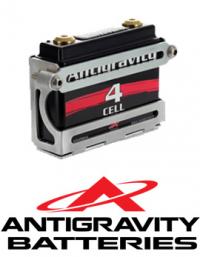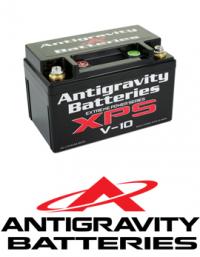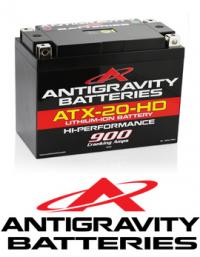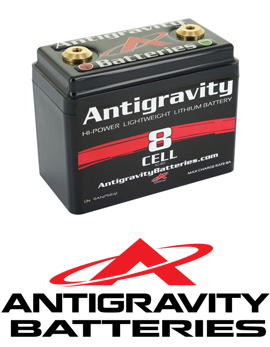FAQS

WHAT IS THE RANGE OF VOLTAGE FOR ANTIGRAVITY LITHIUM BATTERIES?
Electrical / Charging
13.2 – 13.4 V.
The Antigravity Battery normal voltage is 13.2V. The battery will read up to 14.7V immediately after charging. The normal operating range will read between 13.3-14.5V. After a few hours it will self-balance to the 13.3-7 range which is its normal state of charge. The maximum voltage the battery should be exposed to is 14.7V. On the lower end of the voltage range the battery should be put on a charger if the battery voltage drops below the 12.5V range while sitting. The voltage should not be allowed to drop below 11V while at rest. Permanent damage may occur below 11 volts.
HOW DO I CHARGE THE BATTERY?
The Antigravity Battery comes ready to install, and start the bike/vehicle. We do offer BATTERY TENDER LiFePo4 Lithium chargers. We have 0.8-amp, 1.25-amp and 4-amp chargers available.
DO I NEED A SPECIAL CHARGING SYSTEM ON THE MOTORCYCLE TO WORK WITH A LITHIUM BATTERY?
Our lithium batteries will operate perfectly fine with the stock charging system in most motorcycles, powersports vehicles. Where the problem can occur is when charging the battery with a standalone charger. Additionally if you have an aftermarket charging system on your vehicle, note that we cannot warranty the battery for use with aftermarket charging systems due to the fact that we do not test with these and some of these are not regulated as strictly as a stock/standard system found in a motorcycle, powersports vehicle or automobile.
CAN I USE MY LEAD/ACID CHARGER ON A LITHIUM BATTERY?
No! We do not recommend using any lead-acid standalone charger with a lithium battery. The reason is that lead-acid chargers will tend to overcharge a lithium battery. Additionally lead-acid chargers often have special modes like Desulfation Modes that can spike the voltage to the battery. This can damage a lithium battery.
CAN I USE ANY TYPE OF LITHIUM CGARGER ON TEH ANTIGRAVITY BATTERY?
No! This can be dangerous. You should ONLY ever use a Motorsport/Powersports specific Lithium Charger or Maintainer for your lithium battery. Using other chargers can potentially cause an explosion or fire. Lithium has different chemistries and not all lithium chemistries are the same and thus require different chargers. Use only lithium chargers rated for Lifepo4 Lithium Iron Phosphate at the recommended charge rate.
WHAT IS THE MAXIMUM CHARGE RATE FOR AN ANTIGRAVITY BATTERY?
The maximum charging rate will depend on the battery model, and can be found on the battery’s front label.
DOES THIS BATTERY REQUIRE TRICKLE CHARGING?
No! The battery is Maintenance Free and can hold a charge for up to a year PROVIDED the bike/vehicle does not have a PARASITIC DRAIN or accessory taking the energy. IF your vehicle’s charging system is in good working order and you do not have any “parasitic drains” on the bike you should not have to charge this battery; rarely if ever. If you do have longer layoffs we recommend disconnecting or isolating the battery.
HOW CAN I FIND WHAT BATTERY TO USE IN MY MOTORCYCLE?
Use our Battery Finder to see the models of Restart (OEM size) or Small Case batteries that will fit in your stock motorcycle or powersports vehicle.
Note that depending on how you use your motorcycle, you may not find the best result for your needs in our Battery Finder. For example you may want a higher capacity battery if you do a lot of motorcycle touring. Please contact us to personally help you choose the best battery for your application.
WHAT IS THE DIFFERENCE BETWEEN SMALL CASE BATTERIES AND TEH NEW RE-START BATTERIES FOR MOTORCYCLES?
Our Small Case batteries are great for race use and custom builds. They are made to be the smallest format, highest power lithium battery you can buy. They come with onboard balancing and work fine in everything from stock motorcycles to world-class race cars. They come in a small case format that is a more “universal” fit for most vehicles and are not a direct exact fit for stock motorcycles. These batteries do not have the full battery management system that our “Re-Start” batteries offer, but they actually offer a bit more in terms of pure power and a bit more amp hour capacity.
In comparison our Re-Start (RS) batteries are intended more for direct replacement of lead-acid batteries in stock vehicles. The RS batteries offer a direct OEM drop-in fitment but also have a full circuit board with Battery Management System (BMS) that protects the battery from over-discharge and overcharge. So they fit directly into the size format of the lead-acid battery they are replacing while offering a number of protections plus our “restart” feature, which offers a reserve capacity. This allows you to restart your vehicle if it is accidentally overcharged. This restart feature is like having built-in jumpstarting.
WHEN SHOULD I CHOOSE A SMALL CASE BATTERY OVER A RE-START BATTERY?
Our Small Case batteries are most often used in applications where the vehicle has been heavily modified and there is no longer space available for the OEM/stock battery. The Small Case is a favorite of custom builders, and can also be ideal for racing. It is critical that you select a
Small Case battery that is large enough for your application in BOTH cranking amps AND capacity. Some considerations:
1. The Small Case battery often has a bit more amp hours than the Restart version.
2. The Small Case batteries are molded to be in the smallest format possible so they can fit a more universal fitment requirement.
3. The Small Case batteries do not have a full protection battery management system like the Restarts. So in some circumstances the Small Case version can be more beneficial for certain applications where you may need a battery that won’t shut off if the voltage gets too low.
4. For comparison: the Restart battery has a full battery management system with the restart feature and prevention of over-discharge and damage to the battery if the battery was to be over-discharged by leaving the lights on, etc. Whereas the Small Case battery has a balancing circuit board inside but does not have the low-voltage cut-off and overcharge and over-discharge protections of the Restart battery.
CAN I USE A SMALLER OR LARGER BATTERY FOR MY MOTORCYCLE?
Yes you can. It will depend on the application you use the vehicle in. For example if you ride more often on longer distance rides, like Touring or Adventure riding, you would want more AMP HOURS (Capacity), so you would want to go with the Heavy Duty (HD) Versions of the Batteries. But if you are a regular street rider not often going on longer road trips you will be fine with the regular version of the battery. But if you Race you might want to get a smaller battery for extra savings on weight since you will not have all the accessories of a regular street vehicle.
WHAT IS THE SMALLEST SIZE BATTERY I CAN USE FOR MY MOTORCYCLE?
This will ultimately depend on the vehicle’s motor size and if that motor has high-performance parts and was built either “tightly” or “loosely”. So there are many variables to consider when determining the smallest size battery possible. The key is to not put too small of a battery that will be over-stressed and will not have a long life cycle.
1. In general our Restart batteries are recommended for direct replacements in stock and standard motorcycles as they come from the manufacturer. Our Restart batteries are intended to replace the battery in those stock vehicles and our part numbers reflect the same part numbers typically of the manufacturer’s stock battery. When using the Restart battery you should only go with the recommended stock size or our Heavy Duty (HD) version of the stock size.
2. See the FAQ above for when to choose Small Case over Restart. Generally, when using our Small Case batteries, the AG-401 can be used in motorcycles up to 450cc, the AG-801 can be used in motorcycles up to 750cc, the AG-1201 can be used in motorcycles up to 1200cc, and an AG-1601 can be used in motorcycles up to 1800cc.
But it should be noted that this depends specifically on the application in which you intend to use the battery – for example if it is a custom bike with a high performance motor you should go up one size. Examples of best uses can be found on any battery’s page.
CAN I PUT TOO BIG OF A BATTERY IN THE BIKE?
As long as the battery fits into the battery tray of your bike and can be connected correctly and safely a larger size will not hurt the bike but just allow for more Power and Capacity in Amp hours.
Lithium Battery Info
WHAT TYPE OF LITHIUM DOES ANTIGRAVITY USE?
We use Lithium Iron Phosphate also called LifePo4. It charges and works perfectly fine with all 12V vehicle systems, provided the stock system is charging correctly.
CAN LITHIUM CATCH FIRE?
With any energy dense battery there is a potential for fire to occur. But the facts are that there are circumstances that create the issues where the battery can go into what is called Thermal Runaway. Properly manufactured Lithium Batteries are safe. But certain circumstances should be avoided and proper care and maintenance of a lithium battery is vital to help avoid this condition.
Our most recent batteries – the RE-START line of products – have a complete Battery Management System (BMS) that offers the protections needed inside the battery so it cannot get to a point of Thermal Runaway.
WHAT PROTECTIONS ARE BUILT IN TO RE-START BATTERIES?
1. They prevent the vehicle from draining the Re-Start battery below 12 volts over time. This is good for preventing “parasitic drain” issues.
2. They prevent the vehicle from draining the battery below 8 volts during cranking. This prevents it from being used in an application too large for what is intended.
3. They protect against occasional spikes in voltage beyond 14.8. This does NOT include when a regulator has failed and allows system volts to constantly rise above 14.8.
WHAT PROTECTIONS ARE BUILT INTO SMALL CASE BATTERIES?
Our Small Case batteries only have a BMS (battery management system) built-in for cell balancing and are not to be over-discharged or over-charged; they do not have protections against that.
HOW LONG WILL THE BATTERY LAST?
This battery should last about 4-5 years, but this will be determined ultimately by how it is used and treated by the consumer. The type of use as a “starter battery” application provides for long life especially if all is well with your electrical system. But in racing and abusive use the lifespan may be much less. Also, parasitic drains or over-discharging or over-charging the battery will shorten life dramatically or ruin the battery. Just make sure you are disconnecting the vehicle if in storage and that you do not over-charge or let the battery drain below 11V and all will be good for a long time.
WHAT CAN DAMAGE LITHIUM BATTERIES?
Over-Discharge or Over-Charge are the most common causes of damage to lithium batteries.
1. Discharging them below 11 volts.
A) Leaving the battery connected to an unused vehicle for a week or more.
When your vehicle is not running (or being ridden) the battery is not being recharged. The vehicle’s ECU, instrument cluster, theft alarm or other accessories are actively using the battery’s energy. If you do not ride enough these “Parasitic Drains” may drain the battery below 11V relatively fast; this may damage your battery! Watch for this and use a charger maintainer if you are not riding often.
B) Your regulator is faulty and the vehicle is relying more on the battery than it should for powering the vehicle’s electronics.
**NOTE: Older vehicles from Pre-1995 most often have bad voltage regulators by this point in time (over 20 years old). Bikes to be especially concerned about are the 1960s through 1980s vehicles that are often Re-habbed, Modified or made into Custom bikes and Bobbers. These would include Harley Davidsons, and the Honda CBs, CTs etc… Yamaha XS and other bikes of these eras. YOU MUST UPDATE TO A NEW SOLID-STATE VOLTAGE REGULATOR. Having a bad voltage regulator can severely spike the voltage to a lithium battery and cause catastrophic failure and potential for a battery melting down and smoking with a potential for fire in worst case scenarios. Do not install a lithium battery in your vehicle if you have not updated these older systems!
C) You mainly use your vehicle for brief trips and the battery is being drained a lot from cranking without allowing time for the vehicle to charge the battery.
D) The battery is being used in an application where the charging system is not being used (e.g. “total-loss” racing systems).
2. Subjecting the battery to a constant charging voltage above 14.8. (Applicable to all battery categories.)
A) You are using a standalone lead-acid charger instead of a lithium-ion charger. Lead-acid Chargers will over-charge Lithium-Ion batteries and will create a physical swelling of the battery and in worst case scenario cause the battery to melt down. Do not use Lead/Acid Chargers on Lithium Batteries!
B) You are using a non-intelligent charger which cannot properly identify the state of the battery.
3. Subjecting the battery to a constant charging current above the “max charge” current stated on the label.
MY BATTERY HAS SWOLLEN, EXPANDED OR IS BULGING; WHY?
Typically our batteries will not expand or swell in the vehicle. In almost every case where our battery did happen to swell or bulge the reason was from overcharging it, and was almost always in older Harley-Davidson motorcycles or pre-1990s Japanese and European bikes with defective voltage regulators (we recommend you update that if you have an older bike). Here are a couple typical reasons why the battery may be overcharging:
1. The bike is an older 1960s through 1980s motorcycle that has an older style voltage regulator that has gone bad. Most of the bikes from these eras had a mechanical voltage regulator that due to age is now defective and not controlling the voltage and charge to the battery. These old broken voltage regulators can spike voltages of up to 28V to our lithium battery which in some cases can cause swelling and damage to the battery as well as a potential for thermal runaway and even explosion or fire. Our instructions clearly state in the user’s manual to check your system for proper voltage regulator operation. We always recommend a new “plug and play” voltage regulator to update any vehicle’s voltage regulator in pre-1990s motorcycles.
2. Another reason for a battery swelling is that the user is charging the lithium battery with a lead-acid charger or a battery tender type charger. These chargers can overcharge lithium batteries and will cause damage to the lithium battery which include swelling and overcharging with the potential for causing a fire. Therefore we only recommend using a specific lithium charger for motorcycles and vehicles using LIFEPO4 batteries.

BS BATTERIES - FAQ INSTALLATION
HOW DO I KNOW IF MY MOTORCYCLE CAN USE A BS LITHIUM BATTERY?
First of all, you’ll find the right battery that you need with our digital tool battery finder. We advise you to have a professional check the electrical system of your motorcycle before installation. You’ll avoid any overcharging or damages.
If you have vehicles manufactured before the mid-1990’s with generators and / or with external voltage regulators, you must change the voltage regulator to a new modern electronic type as overcharge will damage the battery.
WHAT DO I HAVE TO DO BEFORE LITHIUM BATTERY INSTALLATION?
With our battery charge button, we recommend you to check the battery state before installation. If the charge level is low, recharge it. We also developed spacers to wedge batteries during use.
CAN BS BATTERIES BE MOUNTED IN ANY POSITION?
Absolutely, BS Lithium batteries are non-spillable and provide a wide multi-positioning mounting, up to 180°C.
CAN I USE BS LITHIUM BATTERIES IN COLD TEMPERATURE?
BS Lithium batteries are designed to provide impressive cold crank performance.
The starting capacity of lithium batteries is generally reduced due to cold conditions (below 0°C).
If your motorcycle fails starting, we advise you some alternative solutions :
1. Connect a BS Charger lithium compatible for 30 seconds
2. Turn on the lights for 1-2 minutes before starting. This is to warm up the battery.
WHAT IS THE STARTING PROCEDURE FOR BS LITHIUM BATTERIES?
During the starting procedure, each starting attempt should not exceed 5 seconds, an interval of 5 seconds minimum between 2 starting attempts should be respected. The battery should rest at least 3 minutes after 5 starting attempts.
CAN I USE ANY CHARGER ON BS LITHIUM BATTERIES?
NO! We recommend you to not use any lead acid battery chargers on BS lithium batteries as a desulfation program is included on lead acid charger what will occur irreversible damage.
CAN I TRICKLE CHARGE BS LITHIUM BATTERIES?
BS Lithium batteries don’t require to be maintained during a long period. don’t support a trickle-charge in the way lead-acid batteries do. We advise you to make periodically 30 minutes charge, every two months.





